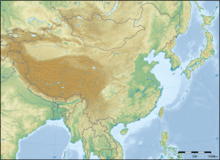This is an old revision of this page, as edited by Epipelagic (talk | contribs) at 22:00, 23 December 2008 (CNFC). The present address (URL) is a permanent link to this revision, which may differ significantly from the current revision.
Revision as of 22:00, 23 December 2008 by Epipelagic (talk | contribs) (CNFC)(diff) ← Previous revision | Latest revision (diff) | Newer revision → (diff)
China accounts for about one-third of the total fish production of the world. According to the FAO statistics, the total fish production in 2005 was 49.5 million tons. Of this total, 65.5% was from aquaculture, an increasing sector, and 34.5% from wild fish caught in rivers, lakes, and the sea.
Aquaculture, the farming of fish in ponds and lakes, accounts for more than half of China's output. China's 2005 reported harvest was 32.4 million tons, more than 10 times that of the second-ranked nation, India, which produced 2.8 million tons. The principal aquaculture-producing regions are close to urban markets in middle and lower Yangtze valley and the Zhu Jiang delta.
China's 2005 reported catch of wild fish was 17.1 million tons, far ahead of the second-ranked nation, the United States, with 4.9 million tons.
Marine fishing grounds
Coastal fisheries


China has a coastline of 14,500 kilometres, and an exclusive economic zone (EEZ) of 877,019 square kilometres. The fishing grounds range from sub-tropical to temperate zones and include 431,000 square kilometres of continental shelves (within 200 meters deep).
| Areas of marine fishing grounds (x1000 km²) | |||
| Region | Area | Continental shelf | Fishing ground |
|---|---|---|---|
| Bohai Sea | 24 | 24 | 24 |
| Yellow Sea | 127 | 127 | 103 |
| East China Sea | 252 | 151 | 160 |
| South China Sea | 630 | 129 | 531 |
| Total | 1033 | 431 | 818 |
There are ongoing disputes with several neighbouring nations over the exact extent of the EEZ in the South China Sea.
The China seas contain about 3000 marine species, of which more than 150 species are fished commercially. Some major marine fishing species in recent times are hairtail, chub mackerel, black scraper (oval filefish or Navodon modestus), anchovy and some species from shrimps, crabs and smaller fishes.
Distant water fisheries

Chinese distant water fishing activities started in 1985. China gains access to new fishing grounds through agreements with foreign countries. By 1996, these fisheries had extended to more than 60 nations or regions around the world. In that year, they employed 21,200 fishermen, 1381 fishing vessels, and caught 926,500 tons.
The China National Fishery Corporation (CNFC) is the major operator in the distant water fisheries. In 1985 it sent the first Chinese fishing fleet to West African waters. In 1986, working with other Chinese partners, CNFC started trawling operations in the North Pacific. In 1988 tuna longlining was initiated in the South Pacific, and in 1989, squid longlining in the Japan Sea and the North Pacific.
Inland fishing grounds
Aquaculture
History
Cormorant fishing

Historically, cormorant fishing has been a significant fishing technique in China. To control the birds, the fishermen tie a snare near the base of the bird's throat. This prevents the birds from swallowing larger fish, which are held in their throat. When a cormorant has caught a fish, the fisherman brings the bird back to the boat and has the bird spit the fish out. Chinese fishermen often employ great cormorants. Though cormorant fishing used to be a successful fishing industry, its primary use today is to serve the tourism industry.In Guilin, China, cormorant birds are famous for fishing on the shallow Lijiang River.
See also
Notes
- ^ FAO 2005 statistics
- CIA factbook: [China
- Sea Around Us Project: China's EEZ
- ^ NOAA Central Library (1996) Fishing Industry in China
- Cormorant Fishing "UKAI". May 2001 version. Retrieved 2008-JAN-30.
References
- FAO: Fisheries and Aquaculture 2005 statistics.
- FAO: Fishery and Aquaculture Profile for China
- FAO: The State of World Fisheries and Aquaculture (SOFIA) 2004: Part 3: Scope of the seaweed industry
- China disputes claim it over reports fish catch Associate Press, 17 December 2002.
- Hart PJB and Reynolds JD (2002) Handbook of Fish Biology and Fisheries Blackwell Publishing. ISBN 9780632064823
- NOAA Central Library (1996) Importance of the Fishery Industry in China
- NOAA Central Library (1996) Fishery Enterprises in China
- NOAA Central Library (1996) Fish processing
- Fishing in China New York Times, 25 March 1877.
- Cairns,D (1948) Fishing Industry in China Tuatara, Vol. 1, issue 2.
- Muscolino, M (2008) [http://www.historycooperative.org/journals/eh/13.2/muscolino.html The yellow croaker war: Fishery disputes between China and Japan, 1925–1935 Environmental History 13(2).
- Chinese Cooperation with International Agreements on Oceanic Issues The Woodrow Wilson International Center for Scholars, October 1997.
| Fisheries and fishing topic areas | ||
|---|---|---|
| Fisheries |  | |
| Fishing | ||
| Industry | ||
| Recreation | ||
| Techniques | ||
| Tackle | ||
| Locations | ||
| Crime | ||










